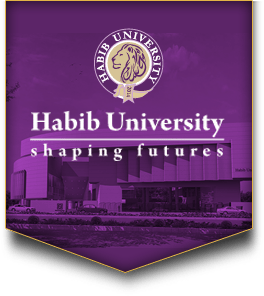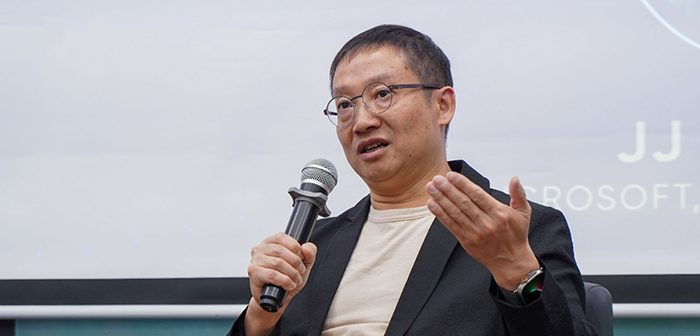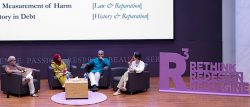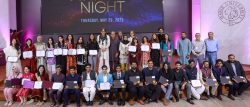As artificial intelligence (AI) continues to evolve, its influence on industries, education, and society becomes increasingly profound. More than a technological phenomenon, AI represents a societal shift that demands a holistic approach to understanding and adaptation. In this transformative era, integrating Humanities and STEM (Science, Technology, Engineering, and Mathematics) offers a blueprint for navigating an AI-driven world—blending technical expertise with critical human-centric values.
This integration was the essence of the discussion at Habib University’s recent fireside chat, “Humanities and STEM in the Age of AI: Skills for the Next Generation,” featuring JJ Zhuang, former VP of Engineering at Instacart and co-founder of Acompli, and moderated by Muneera Batool, Associate Dean – Teaching and Learning, Assistant Professor of Communication & Design, and Dr. Abdul Basit Memon, Associate Professor of Electrical and Computer Engineering.
The Evolving Role of AI in Education and Workplaces
AI is redefining how we learn, work, and create. Zhuang noted that AI is reshaping fields like software development, where rapid prototyping has revolutionized workflows. He remarked that “the way we write code today is completely different from two years ago,” explaining that a significant portion of prototyping is now AI-generated. This shift accelerates innovation and changes how teams approach problem-solving.
However, this rapid transformation brings challenges. Zhuang pointed out concerns about constant monitoring and the fear of losing human agency in a machine-driven world. He emphasized that AI’s growth must be handled thoughtfully, allowing humans to shape tomorrow’s world. Critical thinking and judgment remain irreplaceable as we navigate AI outputs and determine their ethical implications.
Interdisciplinary Skills for the Next Generation

As the boundary between Humanities and STEM blurs, the need for interdisciplinary education has never been greater. Zhuang underscored the importance of skills that merge logical reasoning, critical thinking, and ethical judgment with an understanding of linguistics and communication. He noted that “the combination of these skill sets will be a scarce commodity in a world abundant with AI,” emphasizing the enduring value of human insight.
This perspective aligns with Habib University’s commitment to interdisciplinary education, exemplified through its Habib Liberal Core curriculum. This foundational program encourages students to explore diverse disciplines, blending the arts, humanities, natural sciences, and social sciences. By fostering critical thinking, ethical reasoning, and creative problem-solving, the Liberal Core prepares students to tackle complex challenges with a holistic perspective. This approach equips them with the adaptability and insight needed to thrive in an AI-driven world.
Global Engagement and Collaborative Learning Spaces

Habib University’s ability to convene global leaders and foster transformative dialogues stems from its unique approach to education and its commitment to integrating diverse disciplines. Thought leaders such as Mr. Junaid Quraishi, Managing Partner at MDI Fund; Ms. Malika Junaid, Principal Architect at M.Designs Architects; and Mr. Abu Bakar, CEO of the Pakistan Software Export Board, choose to make Habib the centerpoint of these critical conversations because of its forward-thinking philosophy. The university’s focus on bridging STEM and the humanities creates a space where innovative ideas and meaningful discussions about the future of technology and society thrive.
Habib University is actively exploring the integration of cutting-edge technologies like AI into its curriculum to prepare students for the demands of an evolving world. Through its interdisciplinary approach, the university ensures that students not only gain technical expertise but also develop critical thinking and ethical reasoning skills. This integration is guided by insights from global leaders and events like these, where ideas for designing innovative coursework take shape.
JJ Zhuang aptly noted during the discussion: “The co-location of math and humanities faculty offices at Habib University reflects an essential truth: we no longer have the luxury of separating STEM and humanities. The future demands that we understand many things, not just one.” This philosophy is at the heart of Habib’s mission to equip students with the ability to navigate the complexities of an AI-driven world.
Through these global engagements and its dedication to reimagining education, Habib University has established itself as a transformative institution, fostering collaboration and serving as a catalyst for groundbreaking ideas that drive impactful change.
The Role of Universities in Shaping the Future
Zhuang highlighted a profound shift in the educational landscape, noting that in the past, students were often required to choose between STEM or humanities due to limitations in time and resources—not because learning was inherently siloed. “Now we’re moving into a world where everyone can learn everything,” he remarked, emphasizing the evolving need for interdisciplinary expertise.
In today’s AI-driven world, success demands a blend of diverse skills. Interacting with AI requires significant judgment—while AI guarantees an output based on input, the critical task lies in evaluating that output. Zhuang explained that this process draws on both logical reasoning and problem-solving, traditionally associated with STEM, as well as critical thinking and linguistic understanding, skills often rooted in the humanities. He emphasized, “We are moving into a world where every student will need to know more than just one thing to truly use AI effectively. The combination of logical reasoning and critical thinking rooted in ethics and communication will be the most valuable skill set of the future.”
He further stressed, “The combination of this skill set will become a scarce commodity in a future world abundant with AI.” Habib University’s deliberate integration of STEM and humanities equips students with this valuable blend of expertise, ensuring they are prepared to navigate and shape the complexities of an AI-driven era.
Conclusion

The discussion at Habib University underscored a central theme: the future belongs to those who can bridge the gap between technology and humanity. As industries and societies are reshaped by AI, the integration of Humanities and STEM is seen as essential for fostering innovation, inclusivity, and ethical decision-making. Valuable insights into navigating this transformative era with creativity and adaptability were provided during the fireside chat with JJ Zhuang.




